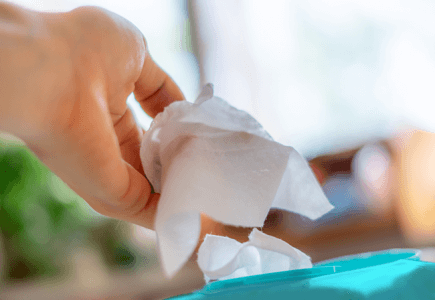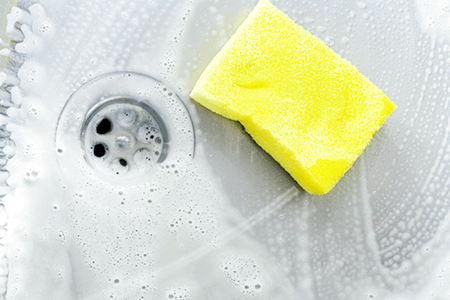Bacteria and Viruses: What's the Difference Between Viral and Bacterial?

It’s not uncommon to hear the words “bacteria” and “viruses” in the same sentence, so it’s understandable that some people think they are the same thing and that the words are interchangeable. The fact is that they are NOT. Now more than ever, it’s important to know how bacteria and viruses are different, what viruses and bacteria have in common, and the best way to protect yourself and your loved ones from both.
Bacteria
What are bacteria?
Bacteria are single-celled, living organisms, and are one of the oldest things on Earth. They have everything they need to survive and reproduce. Bacteria get a pretty bad rap even though most are vital for human health, not to mention the health of the planet’s ecosystems. We have trillions of them in our gut that play an important role in our daily heath, and trillions more that live harmlessly on our skin. Less than 1%—referred to as pathogenic bacteria—cause disease.
What are examples of bacterial infections?
If you’ve ever had food poisoning, a sore throat, or a urinary tract infection, it was the result of a bacterial infection. These are examples of the 1% of pathogenic bacteria that can cause infections in humans. Bacterial infections also include pneumonia, bronchitis, strep throat, meningitis, and tuberculosis. Sexually transmitted diseases, including gonorrhea, chlamydia, and syphilis, are also caused by bacterial infections [*].
How are bacterial infections treated?
Most people have immune systems that are strong enough to overcome the majority of bacterial infections. The most common treatment for severe bacterial infections is the use of antibiotics. These medications work by preventing bacteria from dividing and growing. If you are prescribed antibiotics, it’s important to take the entire prescription as directed, even if you’re feeling better. If you stop too soon, or skip doses, you can prevent the antibiotics from killing all of the pathogenic bacteria in your body [*].
Science has also developed ways to prevent some of the most severe bacterial infections. Vaccinations are used to prevent severe bacterial infections such as tetanus, meningococcal disease, diphtheria, and pertussis [*].
Which products kill bacteria?
The process of killing bacteria is called sterilization. “Sterilization or bacterial killing is brought about by many methods, such as physical methods, irradiation, and chemical agents or disinfectants,” says Dr. Mohammad Nazmul Hasan Maziz, Lecturer in Microbiology at the Perdana University Graduate School of Medicine [*].
Using normal cleaning products can help reduce bacteria on household surfaces, but you need disinfectants to kill them. Some examples of disinfectants that can kill bacteria on surfaces include products that contain alcohol, such as ethanol and isopropyl alcohol, as well as household bleach, and products that contain ammonium compounds.
What you choose to use as a disinfectant against bacteria depends on the surface. A disinfectant product for surfaces is different from a disinfectant product for skin. For example, Nice ’N CLEAN® Disinfecting Wipes kill bacteria on nonporous surfaces, while Nice ’N CLEAN® Sani-Hands® Antibacterial Hand Wipes are designed to kill bacteria on your hands.
Be sure you choose the right disinfectant for the right job, and always follow the manufacturer’s instructions to ensure maximum safety and effectiveness.
Viruses
What are viruses?
Made up of only one piece of genetic material inside a plastic cell, viruses are the ultimate freeloaders whose sheer existence is to reproduce. Unlike bacteria, viruses cannot survive for long without a host cell for energy. Many scientists argue they aren’t even “alive” because they are so dependent on host cells to survive and reproduce. The effects of viruses can range from life-threatening to virtually symptomless.
Most viruses cause disease, and they are very specific about the area of the body they attack. These nasty little parasites are 10 to 100 times smaller than even the smallest bacteria, but they are on a mission—to reproduce and make new viruses out of everything they drain from their host cell. These new viruses then burst out of the host cell, killing it. They go on to infect new host cells—and new hosts. And they repeat the process as long as the infection lasts.
And, even then, it might not be over. Certain viruses, such as the ones that cause chicken pox and cold sores, may become dormant after the initial infection period. You might be symptom-free for days, weeks, months, or even years. Then, a trigger, such as stress, may reactivate the virus. This reactivation leads to new symptoms as the virus goes back to its business of reproducing, releasing new viruses, and killing more host cells.
What are examples of viral infections?
If you’ve ever suffered from a common cold, you’ve been a host to a virus. In fact, many diseases are caused by viruses, such as chicken pox, measles, mumps, and various types of the flu. Viruses are also to blame for hepatitis, rabies, HIV, Ebola, polio, herpes and cold sores, Zika, and severe acute respiratory syndrome (SARS), as well as the new coronavirus SARS-CoV-2 that causes the COVID-19 virus.
And here’s a not-so-fun fact: There is no cure for viruses. Vaccination, however, can prevent them from spreading [*].
How are viral infections treated?
Mild viral infections usually resolve themselves without treatment in people with healthy immune systems, but medication can relieve symptoms such as pain, fever, and cough. That’s a good thing since, as we’ve pointed out, there are no cures for viruses. According to Dr. Fayyaz Sutterwala, director of Infectious Diseases at Cedars-Sinai, “Since each virus is very different, no one drug exists to attack whichever virus is in your body” [*].
Viral infections require vaccinations to prevent them or antiviral drugs to treat them. As Dr. Sutterwala put it, “Vaccines give preemptive protection from certain viruses by training the body's immune system to recognize and attack a specific virus” [*]. Vaccines are the least expensive—and most effective—way to prevent viruses, making them our primary line of defense.
Science has made some advances in the fight against some viruses. For example, antiviral drugs have been engineered that can treat some viral infections, such as hepatitis C or HIV. Antibiotics do not treat viral infections; antibiotics can only treat bacterial infections.
Which products kill viruses?
Most viruses are sensitive to temperature, humidity, and other environmental factors. Some survive without a host for hours or days, while some can remain viable for as long as weeks.
You can eliminate viruses from your home by:
- Boiling water if necessary
- Cooking foods to their FDA-recommended temperature
- Disinfecting household surfaces
Disinfectants that kill viruses on surfaces include products with active ingredients such as ethanol, hydrogen peroxide, and quaternary ammonium. Bleach is also effective in killing viruses. As with their use against bacteria, it is important to follow product instructions, particularly when it comes to the contact time. That’s the length of time a product needs to be wet on surfaces to ensure its effectiveness. Depending on the product, contact times may vary from 3 to 10 minutes. For example, Nice ’N CLEAN® Disinfecting Wipes have a 3-minute contact time for killing viruses and bacteria.
ALSO READ: Cleaning vs. Sanitizing vs. Disinfecting: Understand the Differences
Bacteria vs. viruses: transmission
Most bacterial infections and viral infections are contagious—they can be transmitted from person to person. This can happen through close contact (touching or kissing, for example), contact with an infected person’s bodily fluids (such as when someone sneezes), or contact with a contaminated surface like a doorknob or light switch, and then touching your face. They can also be transmitted from mother to child during pregnancy or birth, through the bite of an infected insect, or consuming contaminated food or water.
Bacteria vs. viruses: symptoms
Symptoms of infection reflect the affected area of the body and the infecting organism, which can lead to differences between bacterial and viral infection symptoms. A bacterial infection of the skin may cause swelling, pain, redness, or even a discharge in the affected area. In contrast, a viral infection may cause joint pain, nausea and vomiting, abdominal cramping, and the skin or eyes to turn a shade of yellow.
Oftentimes, bacterial infections share the same symptoms as viral infections because the symptoms reflect the body’s way of trying to get rid of the infecting organism. Shared symptoms caused by viral or bacterial infections include:
- Coughing
- Cramping
- Diarrhea
- Nausea or vomiting
- Sneezing
- Fatigue
How to prevent bacterial and viral infections
Follow these tips to help prevent bacterial and viral infections.
- Practice good personal hygiene.
- Get vaccinated.
- Stay home if you’re sick.
- Cook food thoroughly.
- Practice safer sex.
- Protect against bug bites.
- Wear a mask when outside your home, and practice social distancing.
- Disinfecting surfaces in your home and workplace regularly.
When it comes to disinfecting, Nice ’N CLEAN® Disinfecting Wipes are proven to kill 99.9% of viruses* and bacteria**, including the COVID-19 virusɸ in 3 minutes. These pre-moistened wipes contain a proprietary solution specially developed to clean, deodorize, sanitize, and, most importantly, disinfect. Safe on hard, nonporous surfaces, Nice ’N CLEAN® Disinfecting Wipes are made with renewable plant-based fibers, and are more than 60% larger than the leading household wipe. When it comes to disinfecting challenges at home, at the office, and at school, don’t trust just any wipe. To effectively kill both bacteria and viruses, use Nice ’N CLEAN® Disinfecting Wipes. They’re currently available in store at Costco.




